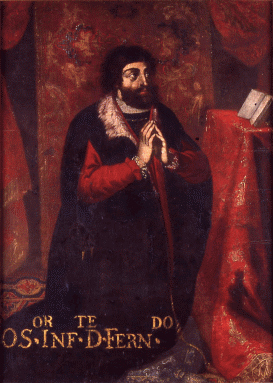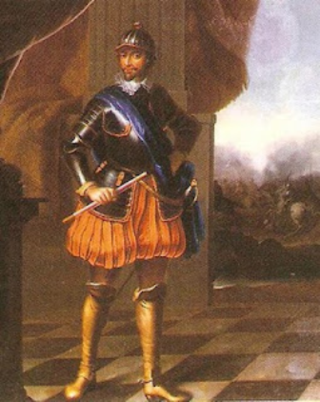External links
- Gerhard J. Bellinger (2004). "Ortiz de Vilhegas, Diogo". In Bautz, Traugott (ed.). Biographisch-Bibliographisches Kirchenlexikon (BBKL) (in German). Vol. 23. Nordhausen: Bautz. cols. 1036–1040. ISBN 3-88309-155-3.
Don Diogo Ortiz de Villegas (de Calzadilla) was a Castilian priest, theologian and astronomer at the service of the Portuguese monarchs. He was born in Calzadilla, Castile, ca. 1457 and died in Almeirim (Portugal), in 1519.
Ortiz came to Portugal in 1476, accompanying Castilian Princess Joanna La Beltraneja. He became an adviser to King John II of Portugal and later Manuel I, being successively appointed Bishop of Tanger (1491–1500), Bishop of Ceuta (1500–1504) and Bishop of Viseu (1505–1519). During his rule, he led a comprehensive artistic remodelling of Viseu Cathedral.
Ortiz advised the Portuguese kings on matters related to astronomy and navigation during the Age of Discovery. Manuel I named him tutor of his heir, future John III of Portugal.
Ortiz taught on the writings of Cato, Terence, Virgil, Sallust and some parts of the Bible, the theory of the planets and some elementary matters about astrology he heard from Tomás de Torres, an eminent doctor and astrologer of that time.

The history of the Kingdom of Portugal from the Illustrious Generation of the early 15th century to the fall of the House of Aviz in the late 16th century has been named the "Portuguese golden age" and the "Portuguese Renaissance". During this period, Portugal was the first European power to begin building a colonial empire as during the Age of Exploration Portuguese sailors and explorers discovered an eastern route to India as well as several Atlantic archipelagos and colonized the African coast and Brazil. They also explored the Indian Ocean and established trading routes throughout most of southern Asia, sending the first direct European maritime trade and diplomatic missions to Ming China and to Japan, at the same time installing trading posts and the most important colony: Portuguese Macau. The Portuguese Renaissance produced a plethora of poets, historians, critics, theologians, and moralists. The Cancioneiro Geral by Garcia de Resende is taken to mark the transition from Old Portuguese to the modern Portuguese language.

Manuel I, known as the Fortunate, was King of Portugal from 1495 to 1521. A member of the House of Aviz, Manuel was Duke of Beja and Viseu prior to succeeding his cousin, John II of Portugal, as monarch. Manuel ruled over a period of intensive expansion of the Portuguese Empire owing to the numerous Portuguese discoveries made during his reign. His sponsorship of Vasco da Gama led to the Portuguese discovery of the sea route to India in 1498, resulting in the creation of the Portuguese India Armadas, which guaranteed Portugal's monopoly on the spice trade. Manuel began the Portuguese colonization of the Americas and Portuguese India, and oversaw the establishment of a vast trade empire across Africa and Asia.

John II, called the Perfect Prince, was King of Portugal from 1481 until his death in 1495, and also for a brief time in 1477. He is known for re-establishing the power of the Portuguese monarchy, reinvigorating the Portuguese economy, and renewing his country's exploration of Africa and Asia.

The House of Aviz, also known as the Joanine Dynasty, was a dynasty of Portuguese origin which flourished during the Renaissance and the period of the Portuguese discoveries, when Portugal expanded its power globally.

The Manueline, occasionally known as Portuguese late Gothic, is the sumptuous, composite Portuguese architectural style originating in the 16th century, during the Portuguese Renaissance and Age of Discoveries. Manueline architecture incorporates maritime elements and representations of the discoveries brought from the voyages of Vasco da Gama and Pedro Álvares Cabral. This innovative style synthesizes aspects of Late Gothic Flamboyant architecture with original motifs and influences of the Plateresque, Mudéjar, Italian, and Flemish architecture. It marks the transition from Late Gothic to Renaissance. The construction of churches and monasteries in Manueline was largely financed by proceeds of the lucrative spice trade with Africa and India.
This is a historical timeline of Portugal's Second Dynasty.

Infante Ferdinand, Duke of Viseu and Beja was the third son of Edward, King of Portugal and his wife Eleanor of Aragon.

Cardinal-Infante Afonso was a Portuguese infante (prince), son of King Manuel I of Portugal and his wife Maria of Aragon.

Diogo Ribeiro was a Portuguese cartographer and explorer who worked most of his life in Spain, where he was known as Diego Ribero. He worked on the official maps of the Padrón Real from 1518 to 1532. He also made navigation instruments, including astrolabes and quadrants.

The Military Order of Saint James of the Sword is a Portuguese order of chivalry. Its full name is the Ancient, Most Noble and Enlightened Military Order of Saint James of the Sword, of the Scientific, Literary and Artistic Merit.

Dom Fernando II of Braganza was the 3rd Duke of Braganza and the 1st Duke of Guimarães, among other titles. He is known for being executed for treason against the King.

Duke of Viseu was a Portuguese Royal Dukedom created in 1415 by King John I of Portugal for his third male child, Henry the Navigator, following the conquest of Ceuta.

Jaime of Braganza was the 4th Duke of Braganza and the 2nd Duke of Guimarães, among other titles. He is known for reviving the wealth and power of the House of Braganza which had been confiscated by King John II of Portugal.

Infanta Beatriz of Portugal was a Portuguese infanta, daughter of John, Constable of Portugal, and Isabella of Barcelos, a daughter of Afonso I, Duke of Braganza.
Henrique Esteves da Veiga de Nápoles, 2nd Lord of the Honour of Molelos (1449–1520) was a Portuguese nobleman and wealthy land owner, the eldest son of Henrique Esteves da Veiga de Nápoles, and therefore scion of the main branch of the Portuguese de Nápoles family.

The Diocese of Viseu is a Latin Church diocese of the Catholic church in Portugal. It is a suffragan of the archdiocese of Braga. Its see at Viseu is in the Centro Region. The current bishop is António Luciano dos Santos Costa.

The Diocese of Guarda is a Latin Church diocese of the Catholic church in central eastern Portugal, a suffragan in the ecclesiastical province of the Latin Patriarchate of Lisbon in southern Portugal.

Infante Diogo of Viseu (1450–1484) was the second son of Ferdinand, Duke of Viseu, and his wife Beatriz, Duchess of Viseu.

Miguel da Silva was a Portuguese nobleman, the second son of Diogo da Silva, 1st Count of Portalegre and of his wife Maria de Ayala, a Castilian noblewomen. He was ambassador of the king of Portugal to several popes, and papal ambassador to the Emperor and others.
Diogo is a Portuguese masculine given name and surname.